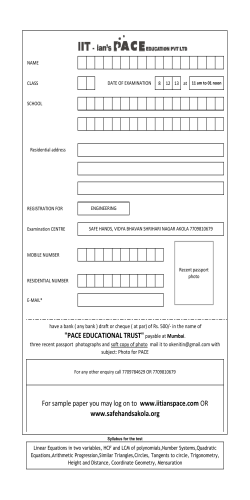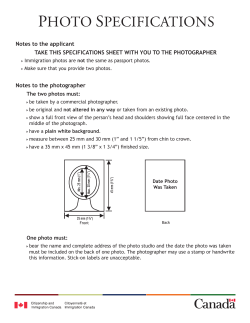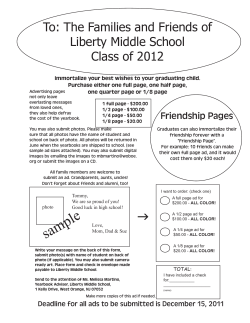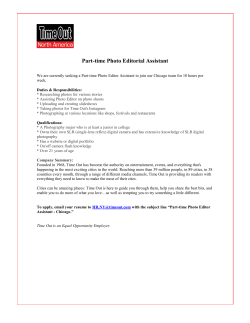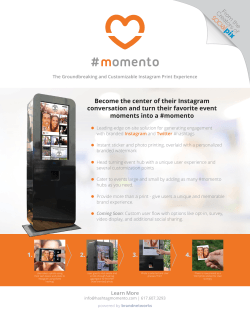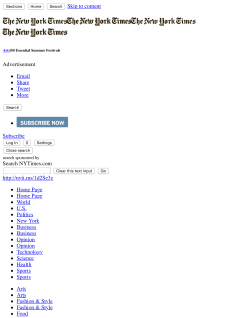
Guidelines for Photographs - High Commission of India, Lusaka
PHOTO SPECIFICATION Applying For VISA APPLICATIONS PASSPORT SERVICES OCI (Overseas Citizenship of India) PIO PCC/Birth Certificate Photograph Size 51 x 51 mm 51x 51 mm 51 X 51 mm 35 X 35 mm 35 X 35 mm Note: The photo requirements are very strict.. Please follow the following instructions accordingly: 1. Center head within frame and present full head from top of hair to bottom of chin. 2. The face should cover about 60-70 percent of the photo area 3. The applicant's head, including both face and hair, should be shown from the crown of the head to the tip of the chin. 4. Please ensure both ears, neck, and shoulders are clearly visible. 5. The head must be centered within the frame. 6. Photo should present Full face, front view, eyes open. 7. Background should be plain white colored without borders with contract colored clothes (not white clothes). 8. Photos with dark, busy, or patterned backgrounds will not be accepted. 9. No shadows on the face or on the background. Do's and Don'ts for a Proper photograph Lighting on face and background 1. The light should be even and balanced to avoid shadows on the face. 2. Background behind the face should be properly illuminated to avoid shadows in the background. 3. Print photo on thin photo paper. 4. Ensure the print is clear and has a continuous-tone quality. 5. Do not retouch or otherwise enhance or soften the photo. Head & Eyes- Position and Background 6. Head should face the camera directly and should not tilt or turned (portrait style). 7. Photo must show both edges of the face clearly. 8. The eyes must be open, level and clearly visible and must not be covered by hairs or eyeglass frames. Eyeglasses 1. Glare on eyeglasses should be avoided with a slight upward or downward tilt of the head. 2. No tinted or dark glasses. Head coverings: Head coverings are not permitted except for religious reasons, but the facial features from bottom of chin to top of forehead and both edges of the face must be clearly shown. Exposure and Lighting 1. There should not be any over-exposure or underexposure which results in an unusable photo. 2. There should be a three-point balanced lighting. Facial features should be clearly evident in the photo. 3. Lighting should be adjusted to avoid shadows on the face or background. Diffuse sources of light, such as umbrella lights, are preferable to point sources. Flexibility in Children's photographs 1. Babies under one year do not have to have their eyes open. 2. As regards the photograph of the children under ten years of age, requirements can be somewhat relaxed in respect of height of the face and the position of the eyes in the photographs; and in case of babies and infants also, the position of the face, the facial expression, the eyes and the line of sight can have some relaxation. However, a frontal photograph with clarity is required for children. 3. It should show the child alone (no chair backs, toys or other people visible) looking at the camera with a neutral expression and the mouth closed. PASSPORT PHOTO INSTRUCTIONS 1)The image should be 2 inches by 2 inches; 2) The image must have adequate brightness and contrast; 3) The skin tone should be natural. In case of over-exposure or under-exposure of the photo, the skin is either too dark or too light, photo will not be acceptable; 4) It should show a close up of the head and (partial) shoulders; 5) The image should be straight looking, centred with neutral expression; 6) Face should be in sharp focus and clear with no ink marks/creases/lines; 7) The face (from forehead edge to bottom of chin) should be 70 to 80% of the photo or one inch height; 8) The eyes must be open and no hair obscuring the face; 9) Prescription glasses if worn should be clear and thin framed and should not have flash reflection or obscure the eyes; 10) Head coverings, hair, head-dress or facial ornaments should not obscure the face; 11) The photo must have plain light background; 12) There must be no other people or object in the photo; 13) The lighting must be uniform with no shadows on the face or behind; 14) Red eye photos are not allowed; 15) No lines are allowed. Photo scan file specification 16) The photo should be ideally printed by professional photo studio with continuous tone; and good resolution. Polaroid photos or photos printed with ordinary printers will not be suitable for scanning. 17) The photo should have preferably been scanned using NIC scanning software available in the NIC-CIPPS uploading software, with 300 DPI setting. If use of NIC scanning software is not feasible, then branded software that comes with the scanner could be used with the following settings :- Color photo; 400 DPI 18) The scanner glass surface should be cleaned regularly, so the scanned photo is clear without any dust; Passports applications with photos that do not match the ICAO specifications are liable to be rejected by foreign immigration authorities, and could result in extreme inconvenience to the passport holder. Annexure “A” SAMPLE IMAGES BAD QUALITY IMAGES T O O D A R K T O O L I G H T D A M A G E D D I R T M A R K S G R A I N Y BAD QUALITY IMAGES GOOD QUALITY IMAGES BAD QUALITY IMAGES H A Z Y O U T O F F O C U S Y E L L O W R E D A S P E C T BAD QUALITY IMAGES GOOD QUALITY IMAGES Annexure “B” Photo Guidlines Requirement of photograph for passports Based upon the specifications of the International Standards Organization (ISO) and ICAO, which is responsible for standardizing travel documents, the most important requirements for a photograph for e-passport is that the face must be taken from a full frontal position and the height of the face must meet the prescribed specifications. The eyes must be open, level and clearly visible with in the indicated area. The face should be centered with in the frame. Advice for Photograph Passport Applicants to Submit Proper Quality The quality of the photograph appearing on the passport depends on the photograph that is submitted at the time of applying for a passport. The passport seekers are, therefore, advised to submit the photographs, as specified, to avoid delay in processing their passport applications. SamplePhoto ● The photograph should be in color and of the size of 2 inch x 2 inch (51mmx51mm). ● The photo-print should be clear and with a continuous-tone quality. ● It should have full face, front-view, eyes open. ● Photo should present full head from top of hair to bottom of chin. ● Center head with in frame. ● The background should be a plain white or off-white. ● There should not be any distracting on the face or on the background. 2 inch 2 inch shadows ● Head coverings are not permitted except for religious reasons, but the facial features from bottom of chin to top of forehead and both edges of the face must be clearly shown. ● The expression on the face should look natural. Do’s and Don’ts for a Proper photo The photo should capture full face, front view, with eyes open. The head should be in the center of the frame. There should be no distracting shadows on the face or background. Distractingba Notcentered ckground 2 inch 1.4 to 1.6 inch 2 inch Make sure photo presents full head from top of hair to bottom of chin; height of head should measure 1.4 inch to 1.6 inch (35mm to 40mm) Lighting on face and background Light should be even and balanced to avoid shadows on Face Background behind the face should be properly illuminated to avoid shadows in the background. Shadows behind Shadows across the head the face PhotographPrintProperties The photograph should be in size 2inch x 2inch (51mmx51mm) and in color. Print photo on thin photo paper or stock. Ensure the print is clear and has a continuous-tone quality. Do not retouch or otherwise enhance or soften the photo. Blurred Inkmarked/ creased ResolutionandPrintingQuality High-resolution photography and printing are strongly recommended. Both conventional and digital photography are acceptable, and conventional or digital printing methods may be used. Resulting print should exhibit a continuous-tone quality regardless of the print method used (dye sublimation, ink jet, laser, etc) Washed out colours Pixilated Digitally printed photos should be produced without visible pixels or dot patterns. Fine facial features should be discernible. ContrastandColor Brightness and contrast should be adjusted to present the subject and background accurately. Photos without proper contrast or color may obscure unique facial features. Color should reproduce natural skin-tones. Fluorescent or other lighting with un-balanced color may cause unLooking Unnatural away skin tones wanted color cast in the photo. Appropriate filters can eliminate improper color balance. Head&Eyes-PositionandBackground Head should face the camera directly and should not tilt or turned (portrait style). Photo must show both edges of the face clearly. The eyes must be open, level and clearly visible and must not be covered by hair or eye-glass frame. Hairsacross Eyesclosed eyes Eye glasses Glare on eyeglasses should be avoided with as light upward or downward tilt of the head. No tinted or dark glasses. Dark tinted lenses Flash reflection on lenses Head coverings are not permitted except for religious reasons, but the facial features from bottom of chin to top of forehead and both edges of the face must be clearly shown. Exposure and Lighting There should not be any over - exposure or underexposure, which results in an unusable photo. There should be a three-point balanced lighting. Facial features should be clearly evident in the photo. Toodark Toolight Lighting should be adjusted to avoid shadows on the face or background. Diffuse sources of light, such as umbrella lights, are preferable to point sources. Flexibility in Children’s photographs Babies under one year do not have to have their eyes open. As regards the photograph of the children under ten years of age, requirements can be somewhat relaxed in respect of height of the face, and the position of the Eyes in the photographs; and in case of babies and infants also, the position of the face, the facial expression, the eyes and the line of sight can have some Shows Mouthopen background andtoyclose relaxation. However, a frontal toface photograph with clarity is required for children. It s h o u l d show the child alone (no chair backs, toys or other people visible), looking at the camera with a neutral expression and the mouth closed. Photographs taken with a digital camera should be of high quality color.
© Copyright 2025
